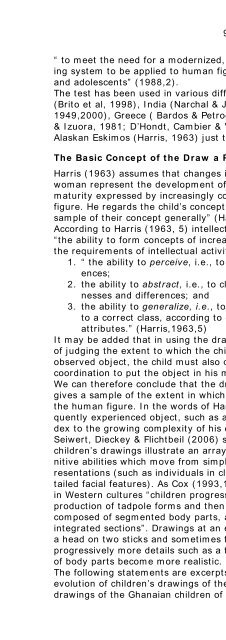4. The Draw a Person Test for Ghana
4. The Draw a Person Test for Ghana
4. The Draw a Person Test for Ghana
You also want an ePaper? Increase the reach of your titles
YUMPU automatically turns print PDFs into web optimized ePapers that Google loves.
9<br />
“ to meet the need <strong>for</strong> a modernized, recently normed, and objective scoring<br />
system to be applied to human figure drawings produced by children<br />
and adolescents” (1988,2).<br />
<strong>The</strong> test has been used in various differing cultural settings such as Brazil<br />
(Brito et al, 1998), India (Narchal & Juneija ,1986), Germany (Ziler<br />
1949,2000), Greece ( Bardos & Petrogiannisc ,1989), West Africa (Ebigbo<br />
& Izuora, 1981; D’Hondt, Cambier & Vandekrie, 1989) and even with<br />
Alaskan Eskimos (Harris, 1963) just to give a few examples.<br />
<strong>The</strong> Basic Concept of the <strong>Draw</strong> a <strong>Person</strong> <strong>Test</strong><br />
Harris (1963) assumes that changes in the child’s drawings of a man or a<br />
woman represent the development of cognitive complexity or intellectual<br />
maturity expressed by increasingly complex representations of the human<br />
figure. He regards the child’s concept of a human figure as “an index or<br />
sample of their concept generally” (Harris, 1963, 5).<br />
According to Harris (1963, 5) intellectual maturity can be considered as<br />
“the ability to <strong>for</strong>m concepts of increasing abstract character” and he lists<br />
the requirements of intellectual activity or concept <strong>for</strong>mation as:<br />
1. “ the ability to perceive, i.e., to discriminate likenesses and differences;<br />
2. the ability to abstract, i.e., to classify objects according to such likenesses<br />
and differences; and<br />
3. the ability to generalize, i.e., to assign an object newly experienced<br />
to a correct class, according to discriminated features, properties, or<br />
attributes.” (Harris,1963,5)<br />
It may be added that in using the drawing of a human figure as a method<br />
of judging the extent to which the child has acquired the conception of an<br />
observed object, the child must also dispose of the necessary visual-motor<br />
coordination to put the object in his mind on paper.<br />
We can there<strong>for</strong>e conclude that the drawing of a human figure by a child<br />
gives a sample of the extent in which he has assimilated the concept of<br />
the human figure. In the words of Harris (1963, 7): “this concept of a frequently<br />
experienced object, such as a human being, becomes a useful index<br />
to the growing complexity of his concepts generally”. Or as Cherney,<br />
Seiwert, Dieckey & Flichtbeil (2006) state, numerous studies suggest that<br />
children’s drawings illustrate an array of mental representations and cognitive<br />
abilities which move from simple (i.e., stick figures) to complex representations<br />
(such as individuals in clothing of different styles with detailed<br />
facial features). As Cox (1993,1) in a comprehensive review notes<br />
in Western cultures “children progress from a period of scribbling to the<br />
production of tadpole <strong>for</strong>ms and then on to conventional <strong>for</strong>ms, at first<br />
composed of segmented body parts, and then later of more contoured and<br />
integrated sections”. <strong>Draw</strong>ings at an early age consist of what seems to be<br />
a head on two sticks and sometimes facial features. With advancing age<br />
progressively more details such as a trunk are added and the proportion<br />
of body parts become more realistic.<br />
<strong>The</strong> following statements are excerpts from a review by Cox (1993) on the<br />
evolution of children’s drawings of the human figure and are illustrated by<br />
drawings of the <strong>Ghana</strong>ian children of our sample:






